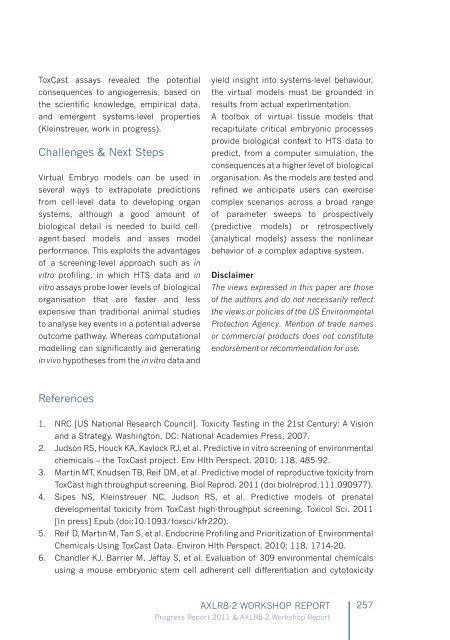Create successful ePaper yourself
Turn your PDF publications into a flip-book with our unique Google optimized e-Paper software.
ToxCast assays revealed the potential<br />
consequences to angiogenesis, based on<br />
the scientific knowledge, empirical data,<br />
and emergent systems-level properties<br />
(Kleinstreuer, work in progress).<br />
Challenges & Next Steps<br />
Virtual Embryo models can be used in<br />
several ways to extrapolate predictions<br />
from cell-level data to developing organ<br />
systems, although a good amount of<br />
biological detail is needed to build cellagent-based<br />
models and asses model<br />
performance. This exploits the advantages<br />
of a screening-level approach such as in<br />
vitro profiling, in which HTS data and in<br />
vitro assays probe lower levels of biological<br />
organisation that are faster and less<br />
expensive than traditional animal studies<br />
to analyse key events in a potential adverse<br />
outcome pathway. Whereas computational<br />
modelling can significantly aid generating<br />
in vivo hypotheses from the in vitro data and<br />
yield insight into systems-level behaviour,<br />
the virtual models must be grounded in<br />
results from actual experimentation.<br />
A toolbox of virtual tissue models that<br />
recapitulate critical embryonic processes<br />
provide biological context to HTS data to<br />
predict, from a computer simulation, the<br />
consequences at a higher level of biological<br />
organisation. As the models are tested and<br />
refined we anticipate users can exercise<br />
complex scenarios across a broad range<br />
of parameter sweeps to prospectively<br />
(predictive models) or retrospectively<br />
(analytical models) assess the nonlinear<br />
behavior of a complex adaptive system.<br />
Disclaimer<br />
The views expressed in this paper are those<br />
of the authors and do not necessarily reflect<br />
the views or policies of the US Environmental<br />
Protection Agency. Mention of trade names<br />
or commercial products does not constitute<br />
endorsement or recommendation for use.<br />
References<br />
1. NRC [US National Research Council]. Toxicity Testing in the 21st Century: A Vision<br />
and a Strategy. Washington, DC: National Academies Press, 2007.<br />
2. Judson RS, Houck KA, Kavlock RJ, et al. Predictive in vitro screening of environmental<br />
chemicals – the ToxCast project. Env Hlth Perspect. 2010; 118, 485-92.<br />
3. Martin MT, Knudsen TB, Reif DM, et al. Predictive model of reproductive toxicity from<br />
ToxCast high throughput screening. Biol Reprod. 2011 (doi biolreprod.111.090977).<br />
4. Sipes NS, Kleinstreuer NC, Judson RS, et al. Predictive models of prenatal<br />
developmental toxicity from ToxCast high-throughput screening. Toxicol Sci. 2011<br />
[In press] Epub (doi:10.1093/toxsci/kfr220).<br />
5. Reif D, Martin M, Tan S, et al. Endocrine Profiling and Prioritization of Environmental<br />
Chemicals Using ToxCast Data. Environ Hlth Perspect. 2010; 118, 1714-20.<br />
6. Chandler KJ, Barrier M, Jeffay S, et al. Evaluation of 309 environmental chemicals<br />
using a mouse embryonic stem cell adherent cell differentiation and cytotoxicity<br />
AXLR8-2 WORKSHOP REPORT<br />
Progress Report 2011 & AXLR8-2 Workshop Report<br />
257




